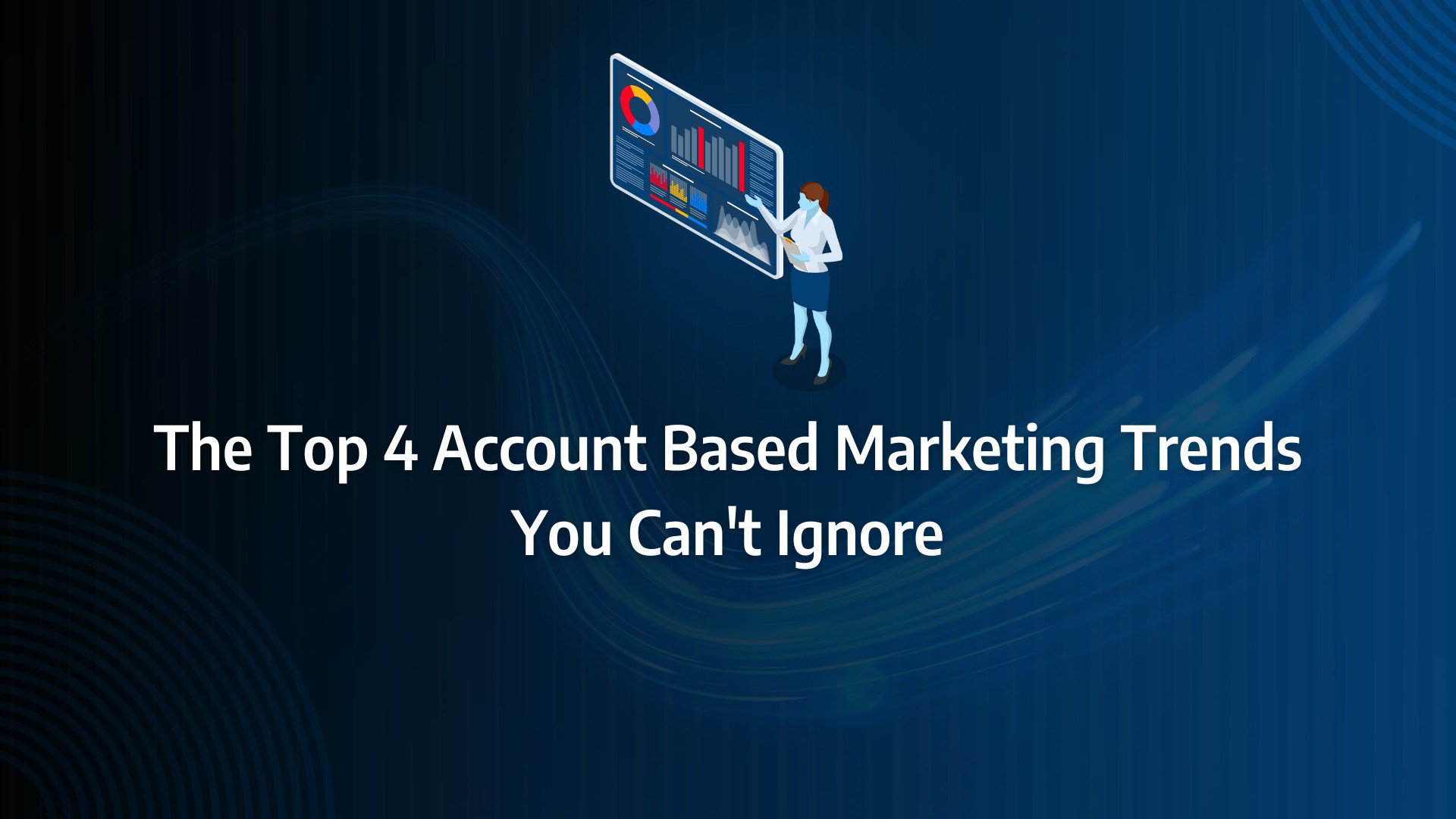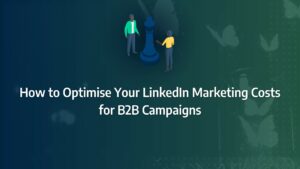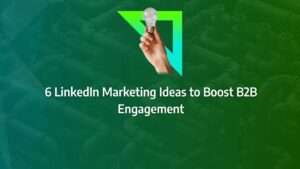Account-based marketing (ABM) is no longer a trend—it’s a necessity. But how do you stay ahead when the landscape is constantly shifting? Understanding emerging ABM strategies, like integrating intent data and leveraging AI, is critical for success.
Imagine knowing exactly when a prospect is ready to engage, or personalising every touchpoint in real-time—that’s the power of these cutting-edge ABM trends. Ready to learn how to transform your approach and capture more high-value accounts? Let’s dive into the top four ABM trends you simply can’t ignore.
- Harness Intent Data: Use intent signals from sources like website visits and content engagement to prioritise high-value accounts and optimise your outreach for higher conversion.
- Embrace Multi-Channel Orchestration: Coordinate your messaging across email, social media, and other platforms to create a seamless and consistent experience for your target accounts.
- Leverage Predictive Analytics: Use predictive models to identify high-value accounts and prioritise your marketing efforts where they will yield the highest return.
- Adopt AI-Driven Strategies: Implement AI tools to enhance personalisation and improve targeting accuracy, helping you to engage with key accounts at the most opportune moments.
- Prepare for a Cookieless Future: Shift your focus to first-party data and privacy-compliant methods like IP-based targeting to continue driving ABM success in a post-cookie world.
Overview of the Latest Account-Based Marketing Trends
Integration of Intent Data
Understanding customer intent has evolved into a cornerstone of effective account-based marketing (ABM). The integration of intent data is set to become even more advanced, empowering marketers with the ability to gain nuanced insights into their target accounts’ behaviours and interests. Intent data, which is gathered from sources such as website visits, content engagement, and social media interactions, offers invaluable signals about a prospect’s readiness to engage or make a purchase.
Leveraging this data allows businesses to prioritise high-intent accounts, tailor their outreach strategies, and engage prospects at the most opportune moments in their buyer journey. This data-driven approach ensures marketing efforts are focused on accounts with the highest likelihood of conversion, maximising both efficiency and impact. As part of the account-based marketing trends of 2024, intent data will be crucial in shaping strategies that align sales and marketing efforts.
Multi-Channel Orchestration
Gone are the days when ABM efforts relied solely on email campaigns or single-channel tactics. In 2024, one of the emerging trends in account-based marketing is the adoption of multi-channel orchestration. This approach allows businesses to engage target accounts across a variety of touchpoints, including email, social media, content marketing, and webinars, creating a seamless and immersive experience for prospects.
By coordinating these efforts, marketers can ensure consistent messaging and branding, providing prospects with a unified message regardless of the platform they engage with. This cohesive, multi-channel strategy significantly increases the chances of capturing the attention of key decision-makers and sustaining engagement throughout the sales cycle.
Enhanced Account Selection with Predictive Analytics
The use of predictive analytics will revolutionise account selection in 2024. As a vital part of account-based marketing predictions, businesses will increasingly turn to predictive models to identify and prioritise high-value accounts. These models analyse historical data, market trends, and various other factors to forecast which accounts are most likely to convert, allowing marketers to direct their resources more effectively.
This data-driven prioritisation not only improves the efficiency of ABM campaigns but also ensures that efforts are focused on accounts with the highest revenue potential. Predictive analytics enables businesses to maximise their return on investment (ROI), making it an essential tool in the modern ABM toolkit.
Real-Time Reporting and Analytics
In today’s fast-moving B2B landscape, real-time reporting and analytics are indispensable for making informed decisions. In 2024, the demand for immediate insights into marketing performance will grow, with real-time analytics providing businesses with up-to-the-minute data on campaign effectiveness, engagement levels, and ROI.
These insights allow marketers to make agile adjustments to their strategies, ensuring that ABM campaigns remain aligned with broader business goals. This account-based marketing trend of leveraging real-time data empowers businesses to stay ahead of the curve, making swift, informed decisions that drive performance.
Cookieless Account-Based Marketing
With the end of third-party cookies, businesses must adapt to a cookieless future. This shift presents a significant opportunity for marketers to refine their account-based strategies using privacy-compliant methods. According to the latest account-based marketing predictions, the success of these strategies will depend on accurate, trustworthy data, with technologies like customer data platforms (CDPs) playing a key role in ensuring seamless data flow between systems.
Marketers will need to lean heavily on first-party data, reverse IP technology, and other innovative solutions to maintain the precision of their targeting efforts. IP-based advertising, in particular, will become a focal point for reaching specific workplace addresses while maintaining compliance with evolving data privacy regulations.
AI-Driven ABM Strategies
The integration of artificial intelligence (AI) into ABM strategies will be a game-changer in 2024, as businesses look for innovative ways to engage with high-value accounts. AI tools will enable marketers to identify key accounts with greater accuracy, deliver tailored solutions, and drive sales growth through predictive insights. As one of the key emerging trends in account-based marketing, AI is transforming how businesses engage with both prospects and existing customers.
Some of the primary benefits include AI-powered keyword intent data, which helps marketers anticipate customer needs and refine their targeting strategies. Moreover, AI tools provide immediate metrics, offering businesses real-time insight into the effectiveness of their campaigns. By using AI to enhance engagement and optimise content delivery, marketers can boost brand visibility and nurture stronger relationships with their target accounts.
What Matters Most?
Leveraging intent data is crucial; it allows us to concentrate our efforts on accounts actively signalling buying intent. From our experience, clients often discover that fostering cross-departmental collaboration between sales and marketing creates a unified strategy that significantly enhances engagement. Moreover, adapting to market trends is essential; by remaining attuned to shifts in buyer behaviour, we can refine our strategies and maintain relevance. This combination of focused targeting and agile adaptation typically leads to more meaningful connections with high-value accounts.Get In Touch
How Data-Driven Personalisation is Influencing ABM Strategies
The Role of Data in ABM
From start to finish, account-based marketing (ABM) hinges on data. It’s essential to use data to identify in-market accounts and their corresponding buyer personas. More than just targeting, data allows you to craft personalised experiences and messaging that resonate with key decision-makers. One of the critical benefits of data-driven ABM is the ability to monitor campaign performance more accurately. By measuring success through real-time pipeline impact, marketers can continually optimise campaigns, rather than waiting until the campaign ends to evaluate what might have gone wrong.
By leveraging data for enhanced targeting, personalisation, and ongoing optimisation based on specific buyer needs, B2B marketers can drive higher levels of engagement and expedite the conversion of target accounts at every stage of the sales cycle. This focus on real-time adjustments ensures ABM strategies remain agile, in line with account-based marketing trends that focus on precision and personalisation.
Why Personalisation Matters
Today’s B2B buyers no longer simply want a personalised experience—they expect it. According to McKinsey, 71% of consumers anticipate brands to provide personalised interactions, while 76% express frustration when these expectations aren’t met. Personalisation, therefore, is no longer optional—it’s a demand that needs to be met.
However, true personalisation goes beyond simply addressing a prospect by name. It requires an engagement strategy that delivers content and messaging tailored to the individual pain points of each buyer, at every stage of their journey. This level of personalisation demonstrates empathy, showing that your brand understands and addresses the unique challenges faced by each customer.
With data-driven ABM, businesses can engage with accounts at a highly personalised level, a tactic that significantly outperforms traditional marketing strategies. According to Forrester, 56% of marketers assert that personalised content is the key to a successful ABM strategy. By delivering tailored messaging at each point in the sales cycle, businesses can build trust and brand awareness, significantly boosting conversion rates. This aligns with emerging trends in account-based marketing, which emphasise personalisation as a pivotal element in future-proofing ABM strategies.
Using Data in Account-Based Marketing
#1 Connect Your First-Party Data
Before launching a successful ABM strategy, it’s essential to fully understand your current customer base. This requires gathering critical insights, such as:
- Who your key contacts are within each account
- How frequently and in what capacity they engage with your business
- The specific types of content they interact with
To achieve this comprehensive view, you must consolidate first-party data from multiple sources, including CRM systems, website interactions, social media engagement, advertising impressions, product usage, emails, and meetings. This data integration will not only enhance your understanding of your relationships with existing customers but also reveal the content they find most engaging. Given that 80% of consumers are more likely to purchase from a company offering a personalised experience, this is a crucial step in optimising engagement and conversion.
Although it may sound straightforward, this process involves gathering data from a variety of platforms, cleansing it to ensure accuracy and relevance, and then analysing it to derive actionable insights. For those in the early stages of shaping an ABM strategy, having a clear view of current customers will enable you to define characteristics for your ideal customer profile (ICP), helping you to target accounts that align with your business model.
#2 Augment Intelligence with Third-Party Data
After consolidating your first-party data, the next step is to enrich this intelligence with third-party data. This process involves researching and gathering additional information, including:
- Industry size
- Key influencers and decision-makers’ job titles within target organisations
- Technographic data
- Intent data
- Industry news influencing their pain points
Personalisation is key in ABM, and 76% of consumers expect a more tailored digital experience from businesses. Leveraging third-party data gives you the broader market context and macro-level insights necessary to refine your ABM strategy. This ensures the content you deliver is not only personalised but also highly relevant to both the customer’s business and the wider industry they operate in.
#3 Use AI to Derive Insights from Your First- and Third-Party Data
Once you’ve combined your first- and third-party data, AI-powered tools can help you interpret this information to drive your ABM strategy forward. By applying techniques such as predictive analytics and propensity modelling, you can:
- Identify and score buying patterns
- Recognise other accounts showing similar engagement trends
- Predict pipeline developments
These insights allow you to pinpoint new opportunities within your existing accounts as well as identify target accounts that show strong potential. This data-driven approach forms a central pillar of the emerging trends in account-based marketing, as businesses increasingly turn to AI to refine their strategies and improve decision-making accuracy.
Using Personalisation in Account-Based Marketing
Steps to Implement ABM Personalisation
- Identify Your Target Accounts
The first critical step in implementing ABM personalisation is identifying the target accounts you want to focus your marketing efforts on. Consider factors such as industry, company size, and geographic location when selecting these accounts. By doing so, you’re laying the groundwork for a more tailored and precise approach that aligns with the latest account-based marketing trends.
- Gather Data and Insights
Once you’ve identified your target accounts, the next step is to gather detailed data and insights about them. This involves understanding their pain points, business challenges, goals, and preferences. The more data you can gather, the better positioned you will be to personalise your content effectively. This data-driven approach is in line with emerging trends in account-based marketing, where deeper insights lead to more effective engagement.
- Create Personalised Content
Armed with your insights, it’s time to create highly personalised content for each account. This could include bespoke emails, customised landing pages, case studies, or even targeted digital ads. Tailor the messaging and tone to resonate with each account on an individual level, addressing their unique needs and challenges. This personalised touch helps you build stronger relationships and trust with your prospects.
- Focus on Key Personalisation Elements
When personalising ABM content, it’s essential to focus on the elements that will have the greatest impact. You don’t need to personalise every aspect of your campaign—targeting the most important pain points and offering tailored solutions will drive better results. By concentrating on the key elements that resonate with each account, you align your strategy with current account-based marketing predictions, ensuring your efforts are both efficient and effective.
To do this successfully, deep research is essential. Understanding the industry, business objectives, challenges, and pain points of your target accounts will allow you to craft content that speaks directly to their needs and interests.
- Tailor Content to the Buyer Journey
Another critical factor in successful ABM personalisation is considering the buyer journey. Your content must align with the various stages of this journey—awareness, consideration, and decision-making. By providing relevant content at the right stage, you’ll help guide your target accounts through the funnel more effectively, improving engagement and accelerating conversion. This approach ensures that your content strategy is not only personalised but also strategically designed to move prospects closer to a decision.
Our Tactical Recommendations
To drive successful account-based marketing, we recommend utilising LinkedIn’s advanced targeting features, enabling us to reach the right decision-makers directly. Clients often discover that creating multi-channel campaigns, integrating both digital and offline strategies, maximises engagement across different touchpoints. Furthermore, we emphasise the importance of A/B testing various campaign elements. This iterative approach allows us to identify which tactics resonate best with our audience, ultimately driving more effective and responsive marketing efforts.Get In Touch
The Role of AI and Automation in Modern Account-Based Marketing
- AI-Powered Account Identification and Prioritisation
Traditional ABM strategies have historically relied on manual research and subjective criteria to identify target accounts. However, AI has transformed this process by employing predictive analytics and machine learning algorithms to analyse vast amounts of data. AI helps to accurately identify the accounts most likely to convert, enabling a more focused and data-driven approach to account targeting.
Key Benefits:
- Precise identification of high-value accounts
- Data-driven prioritisation based on conversion likelihood
- Increased efficiency in targeting efforts
This shift represents one of the key account-based marketing trends emerging in 2024, where marketers can now rely on AI to streamline account selection and maximise the return on their efforts.
- Hyper-Personalisation with AI
Personalisation has always been at the core of effective ABM, and AI is pushing this even further with hyper-personalisation. By analysing data from various touchpoints, AI creates highly detailed profiles of each account, enabling the delivery of tailored content and messaging at a granular level. This hyper-personalised approach fosters deeper engagement and stronger relationships with key accounts, enhancing the overall ABM strategy.
Key Benefits:
- Detailed account profiling for customised content
- Real-time personalisation based on account behaviour
- Increased engagement and relationship building
This capability aligns with the emerging trends in account-based marketing, where hyper-personalisation is becoming a critical factor in driving engagement and conversion.
- Predictive Analytics for Proactive Decision Making
AI’s predictive analytics capabilities empower marketers with foresight into future behaviours and trends. By understanding the actions most likely to result in conversions, businesses can make proactive, informed decisions and adjust their strategies accordingly. Predictive analytics allows marketers to anticipate account needs and deliver timely, relevant solutions that align with the buyer’s journey.
Key Benefits:
- Insights into future account behaviours
- Proactive adjustments to strategy
- Enhanced ability to meet evolving account needs
As part of the broader account-based marketing predictions for 2024, predictive analytics will play a vital role in enhancing decision-making and ensuring ABM campaigns remain agile and effective.
Automation in ABM
As the complexity of the marketing landscape increases, the combination of ABM and marketing automation platforms emerges as a powerful force. The synergy between account-centric strategies and automated workflows enables marketers to deliver highly targeted campaigns with greater efficiency. This section explores the untapped potential of this integration, offering a strategic perspective on how automation is reshaping ABM.
Navigating the ABM Landscape
Navigating today’s ABM landscape requires a deep understanding of both the strategic framework and the critical role of personalisation. It also demands an honest appraisal of the common challenges businesses face when implementing ABM.
Identifying ABM Strategies
ABM is not a one-size-fits-all strategy. It encompasses several approaches, including one-to-one, one-to-few, and one-to-many models, each designed to meet different business goals. A nuanced understanding of these strategies provides marketers with a versatile toolkit to address diverse business needs.
The Role of Personalisation in ABM
Personalisation is a cornerstone of ABM, but it extends beyond addressing contacts by their names. It requires a deep understanding of each account’s pain points, industry challenges, and goals, allowing marketers to craft content that speaks directly to these factors. This human-centric approach enhances engagement and builds long-term relationships.
Overcoming Common ABM Challenges
While ABM offers significant advantages, it also comes with its own set of challenges. From aligning sales and marketing teams to maintaining a consistent customer experience, navigating these obstacles is crucial for successful ABM implementation. Addressing these issues head-on ensures the long-term success of ABM strategies.
A Paradigm Shift in Marketing
The traditional marketing funnel is evolving into a more cyclical model, where personalised interactions drive engagement and conversions. Integrating ABM with automation platforms aligns perfectly with this shift, enabling businesses to deliver consistent, targeted messaging across multiple touchpoints.
The Role of Technology
The success of this integration relies heavily on advanced technologies. Machine learning, AI, and predictive analytics provide the foundation for crafting personalised campaigns at scale. Technology serves as the backbone, enabling both ABM and automation platforms to reach their full potential.
Setting the Stage for Integration
Successful integration requires more than just technological readiness; it demands cultural alignment across the organisation. By uniting teams under a shared vision and fostering a collaborative workflow, businesses can lay the groundwork for a seamless integration that maximises the potential of both ABM and automation.
Future Trends in Account-Based Marketing
As we move forward, the landscape of account-based marketing (ABM) continues to evolve, presenting marketers with an array of new opportunities. Driven by data proliferation, rapid technological advancements, and changing B2B buyer behaviour, ABM strategies are becoming more complex yet more powerful. Marketers now face the challenge of leveraging these advancements while managing the same budget constraints. Deciding where to allocate resources, particularly when it comes to new technologies like generative AI, will be key. While AI is a compelling investment, marketers will need to find ways to trim costs in other areas to accommodate this shift.
Looking ahead to 2025, there are two major areas where organisations should focus their investment:
Data, Signals, and Insights
Marketers must prioritise mastering signal visibility, improving data quality, and refining their comprehensive data strategies, including first, second, and third-party data. Training large language models to improve AI outcomes, building a 360-degree view of buyers and customers, and designing an experience that meets their needs at every stage of the customer lifecycle will be crucial for continued growth. Whether through cross-selling or upselling, creating a seamless customer journey will be essential to stay competitive.
People and Workflows
As buyer behaviours continue to shift, businesses need to adapt how their sales, marketing, and customer success teams operate. Buyers are increasingly self-guided in their research, only reaching out when they are ready to make a decision. When they do engage, they expect businesses to have thoroughly analysed and prioritised their signals. Focusing on delivering an outstanding buyer experience must become a key priority in 2025, not just within marketing but also through cross-functional collaboration. This will involve reevaluating event strategies, onboarding chatbots as essential customer service tools, and overcoming organisational obstacles that can hinder the revenue process.
These trends reflect the growing complexity of ABM, as marketers strive to do more with less, while remaining agile and responsive to the changing needs of their target accounts. As such, staying ahead of these account-based marketing predictions is crucial for maintaining a competitive edge.
What’s the Next Big Thing in Marketing?
Voice Search
While traditional search isn’t going anywhere, voice search is rapidly gaining momentum. Studies suggest that around 50% of mobile users engage with voice search daily, thanks to the growing adoption of voice assistants like Amazon Alexa and Apple’s Siri. These tools are becoming integral to how users interact with technology, providing faster, more intuitive ways to search for information.
Voice search queries tend to be longer, more complex, and conversational, mimicking the way people ask questions in real life. For businesses, this means optimising content to reflect natural, spoken language. Incorporating long-tail keywords and ensuring content answers the kinds of questions users are likely to ask via voice will be essential to maintaining visibility in this evolving landscape.
Augmented Reality (AR)
Another trend that’s rapidly gaining traction is the use of augmented reality (AR). More brands are incorporating AR technology to enhance the shopping experience, allowing customers to visualise products in real-world settings before making a purchase.
Here are a few ways AR is currently being utilised:
- Try Before You Buy: Brands like IKEA offer apps that allow users to place virtual 3D models of furniture into their homes, giving them a sense of how the product will look and fit before making a purchase. This concept extends to cosmetics, home décor, and other product categories, providing a unique and engaging way to shop.
- In-Store Experiences: AR can also transform physical retail experiences. For example, beauty brands like Sephora use AR mirrors, allowing customers to virtually try on makeup, while Amazon’s AR app enables users to scan products in-store for additional information or to visualise how an item might look at home.
- Interactive Marketing Campaigns: Brands are leveraging AR to create interactive experiences, similar to the Pokémon Go phenomenon. Through scavenger hunts or virtual games, brands can engage customers in a more immersive way, encouraging deeper interaction with their products.
- Social Media Filters: Platforms like Instagram and Snapchat have long offered AR filters that users can apply to photos and videos. Many brands now create custom filters to promote their products, offering a fun, shareable way to reach a broader audience.
As AR becomes more reliable, accurate, and accessible, we can expect to see a continued rise in its use across industries, offering consumers a more dynamic and interactive way to engage with brands. These emerging technologies represent a shift in how marketers will need to approach both online and offline engagement, aligning closely with emerging trends in account-based marketing.







